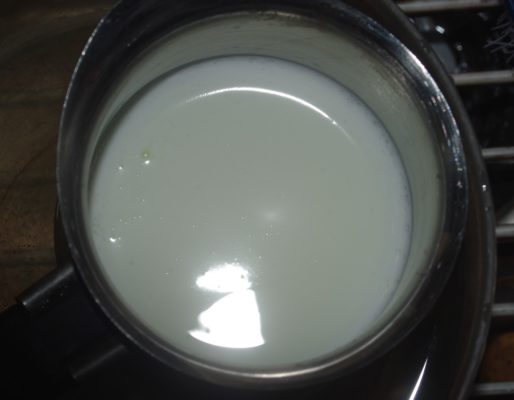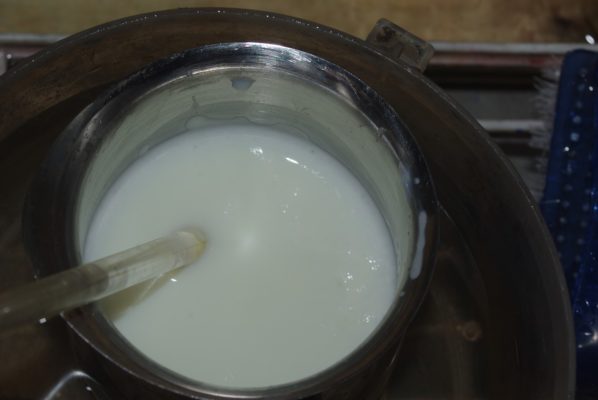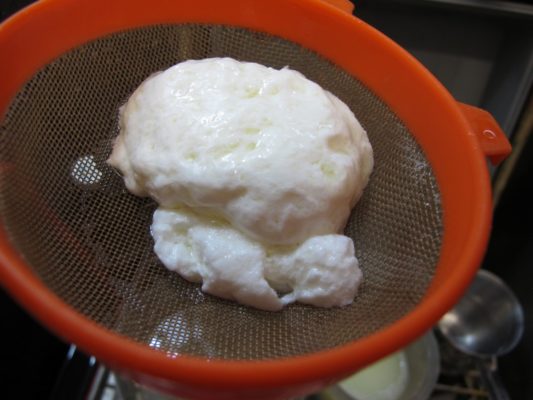Casein Printing from the Kitchen Sink Author Dr.Selby Markham
Procedure for Preparing Casein
The quantities used below can be proportionally increased or decreased to meet your needs.
- Prepare a solution of 4gms citric acid in 20ml water (preferred) Or 15mls vinegar
Note: You will not use all of this acid solution in the separation process. It is a conservative quantity to cover local variations. - Dissolve 30gm of skim milk powder in cool water to make up 300mls of reconstituted skim milk.
- Warm the reconstituted milk to about 40°C by placing the container with the skim milk in a water bath or in a double boiler and applying heat. Try not to exceed 45°C.
- Fill a dropper or pipette with dilute citric acid or vinegar.
- Slowly add about 10-15 drops of acid into the milk, stirring gently.
- After about 30 seconds, add another 10-15 drops while gently stirring.
- Wait for about a minute and a half
- Repeat from 5. watching the changes in the milk
- When the casein is ready there should be an irregular white lump floating in a translucent yellow-green fluid, the whey. This could take 20 minutes.
- The casein may form a few smaller lumps but that is OK. The colour and consistency of the fluid is a good indicator.
- Remove the casein from the whey onto a kitchen strainer and drain.
- Place onto kitchen paper or news print, or use a kitchen strainer, and press dry to the level you want.
This should yield about 35gm of crumbly, moist casein. In this state it dissolves very easily sodium bicarbonate, ammonia and Borax.
Drying your caseine
The moist casein can be dried for longer term storage. This reduces the pressure to manufacture raw materials for each session.
- Press the mass of casein between tissue, blotting paper or newsprint to remove as much water as possible. It is dry enough when you are able to crumble bits of casein off the edge without it clumping.
- Crumble the resulting mass of casein into pieces as small as you can make them but no bigger than half the size of a grain of rice.
- Wash with one of the following alcohols: isopropanol, ethanol or methanol. Add enough alcohol to wet the pieces of casein (about 30ml for 35gm), then swill the casein pieces around.
- Drain off the alcohol and place on a piece of paper towel to absorb the bulk of the excess alcohol. Transfer to a non-absorbant surface and place in front of a fan for at least an hour or until the rest of the excess alcohol has evaporated off.
- OR if you do not wish to use alcohol, place the pieces on some absorbent paper, turning them over occasionally. Place the pieces in either an airy position or in front of a fan. You can use a fan heater that is not too hot. The aim is to dry off excess moisture before the next step – otherwise they might go sour.
- Let the casein fully dry by spreading on a warm non-absorbant surface for about 12 hours. Occasionally turn the grains over so that they do not stick to the surface and do not clump.
- Store the dried casein in an airtight container.
This should yield about 10 gm of dry casein.
Reconstituting the dry casein
Add 15-20 ml of warm water to each 5gm of dried casein. The suggested moisture content for casein is about 20%
Allow to stand for about 12 hours. The grains should now be mushy – the casein will not dissolve but will soften.
Use as if it is crumbly, moist fresh casein
Making Caseinates




